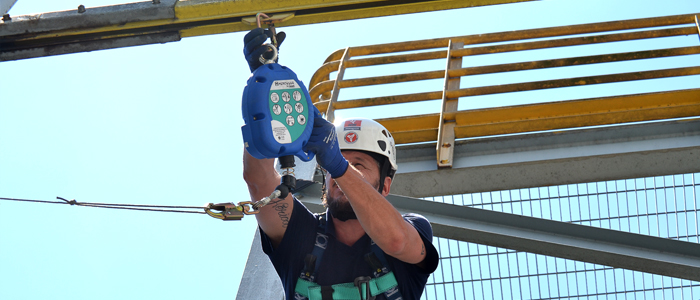Working at height requires very special care when it comes to safety. So much so that there is a specific NR for this type of activity, NR 35. Among the Personal Protective Equipment necessary and mandatory to protect the professional who works at least 2 meters above the ground, two popular PPE are the Fall Arrest Device and the Lanyard. Do you know the difference between them? We’ll explain in this post. 😀
The two PPEs are essential to prevent the professional from suffering a fall and stay protected when performing Work at Height. They are used to provide firmness and safety while workers perform activities on scaffolding, suspended on chairs cleaning the façade of buildings, in maintenance of poles and any other type of activity in which they need to be suspended.
Characteristics of the Fall Arrest Device
A Fall Arrest Device is a mechanical locking device that is intended to connect the Safety Harness to the anchorage point to prevent the worker from falling while working.
The Fall Arrest Device can be found in two different types:
Sliding: being attached to a lifeline placed in a vertical position and makes the displacement movements on an anchorage line that can be rigid or flexible.
Retractable: composed of a coiled cable or strap, which retracts or extends by means of a spring, depending on the worker’s vertical displacement.
Lanyard Characteristics
Each lanyard is developed to attend specific demands for Work at Height. It must also be connected to the Safety Harness and to an anchorage point, but it has a larger fall space than the Fall Arrest Device, which locks at the moment when there is a stronger impact. The lanyard has a clearance that allows a slightly longer fall, and it is mandatory to have a free-fall distance to follow.
The lanyard can be found in three different types:
Single Leg Lanyard: composed of only one leg being one end with a connection point to connect to the harness and the other to the reliable anchorage point and should be used in situations with lower risk level for the execution of Work at Height.
Twin Leg Lanyard: Usually Y-shaped, composed of a connection point to the Safety Harness and two connection points, to connect to the reliable anchorage points. For structures such as scaffolding, the use of the Twin Leg Lanyard is mandatory.
Work Positioning Lanyard: it works as a system to position the worker, and cannot be used for fall arrest. Therefore, it must be used in conjunction with the Single Leg Lanyard, Twin Leg Lanyard, and even with the Fall Arrest Device.
Safety at heights
The safety of the professional who does Work at Heights must be in first place. It is important to know the type of work that will be done, what risks this worker is exposed to, in order to correctly decide which PPE to use, the Fall Arrestor or the Harness. Regardless of the choice, the use of this equipment is mandatory.
Now tell us, what did you think about the explanation about the differences between the two PPEs? Do you think we missed any information? Give us your opinion in the comments!
And whenever you need reliable information about Lanyards and Fall Arrest Devices, come visit us, because this is the Experts in Work at Height Blog.
